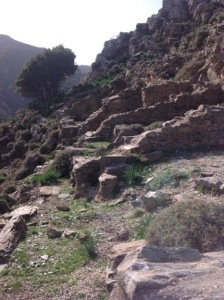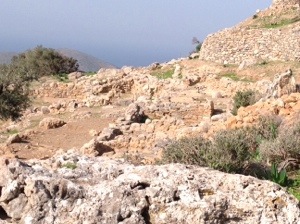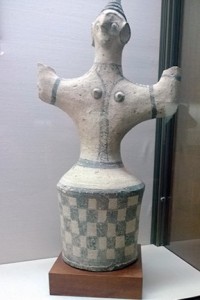Today we had another mountain adventure. We set out in our vans and headed to meet some pickup trucks in the town of Kavousi that would take us to the top of the mountains. Kavousi is a historic village in the municipality of Ierapetra, and it literally translates as “water source.” Many archaeological sites have been discovered in Kavousi. First we traveled up quite high to the most prominent refuge site,the upper settlement, Kavousi Kastro, or “castle,” located on the peak of Kastro in the Thripti range of the Siteia mountains. Kastro was in use from Late Minoan IIIC until the Orientalizing period. We took a leisurely walk down to the associated site, Kavousi Vronda, which was in use from the end of the Bronze Age throughout the Iron Age. These sites were excavated originally by Harriet Boyd in 1900 for the American Exploration Society, and later in 1981-84 and 1987-90, 92, by Gesell, Day, and Coulson for the American School. Harriet Boyd used to be a guest lecturer at our very own Wellesley college!
By living in this refuge site, inhabitants of Kavousi sacrificed some of the comforts afforded to other Cretan settlements in exchange for the protection and isolation offered by the high mountains. For example, today the nearest water source is at Xerambela, which is a 45 minute walk below Kastro.
During our presentation, my partner Caitlin made some intriguing remarks. She claimed
“Because of Kavousi, we have learned much about the foundation, growth, and development of an Early Iron Age community from its inception early in Late Minoan IIIC until the end of the 7th century. Kavousi helps modern scholars understand the Dark Ages due to otherwise limited material available and demonstrates how the Cretans transitioned from the Bronze Age to the Iron Age (Late minoan III C-7th c.).”
The architects wanted to maintain a high level of quality and the old grandeur of the palaces in pretty difficult terrain, as we experienced while hiking. We get buildings from different time periods all working within the same environment. In this way Kavousi actually acts as a great way to see how living areas progressed and changed from one period to another, all in the same site and by people with familial ties.

The best preserved architecture on the site is of Building A. It is most likely a five room house from LMIIIC. In contrast to earlier architecture, the high quality of the masonry indicates the level of attention and care put into the construction of Building A, as seen by such features as niches, the bin, the oven, and the bases, and by the fact that certain walls are still standing over three meters high. On the opposite west slope, we see facades, larger room sizes, and axial symmetry or regular internal dimensions. These structures were built during the Late Geometric period, and the architects were attempting to overcome the extreme slope, instability, and erosive tendencies of the narrow terraces in order to build something just as magnificent as those built on level ground.
 After Vronda, we got back on the pickup trucks and headed to Azoria, another archeological site with some beautiful intact walls and a particularly large gathering area. Boyd even has a trench named after her here. The was definitely some type of round storage in this trench lined with clay. I wondered if they had stored water there as it would have been hard to keep enough for even a small village .
After Vronda, we got back on the pickup trucks and headed to Azoria, another archeological site with some beautiful intact walls and a particularly large gathering area. Boyd even has a trench named after her here. The was definitely some type of round storage in this trench lined with clay. I wondered if they had stored water there as it would have been hard to keep enough for even a small village .
We headed back in the pickup trucks, visited the olive tree civilization in Crete, and took a picture surrounding a tree estimated to be 3250 years old. That’s way older than pretty much any treeI can imagine. Back in the pickup trucks, and we went to a local cafe for some down time.




